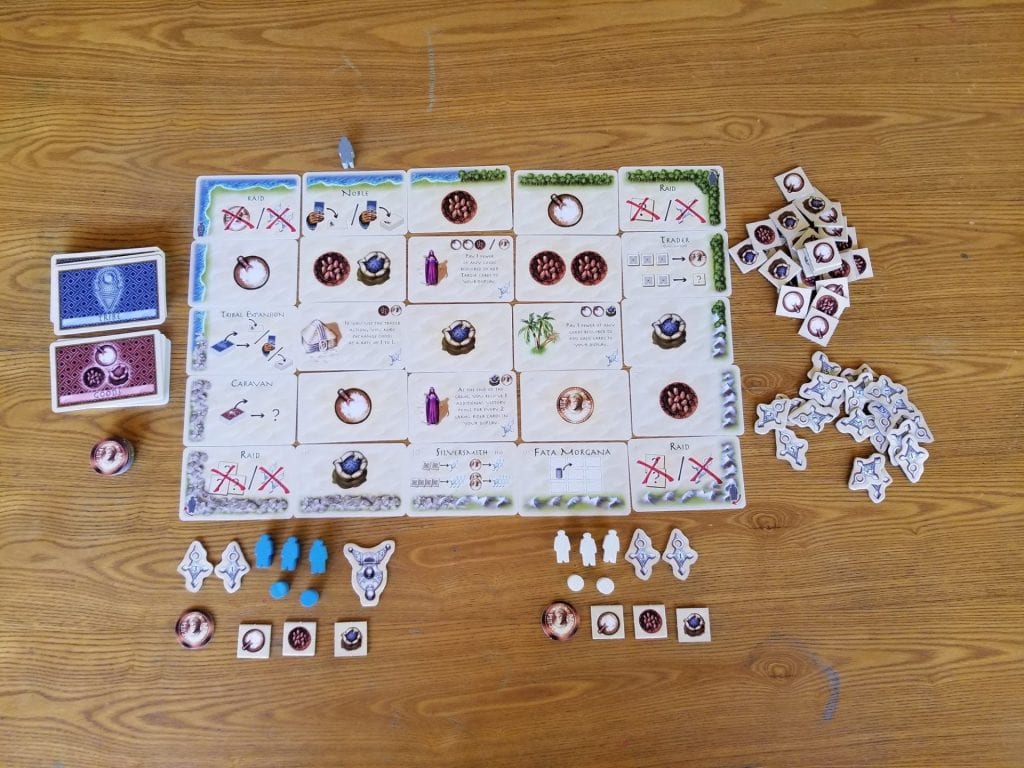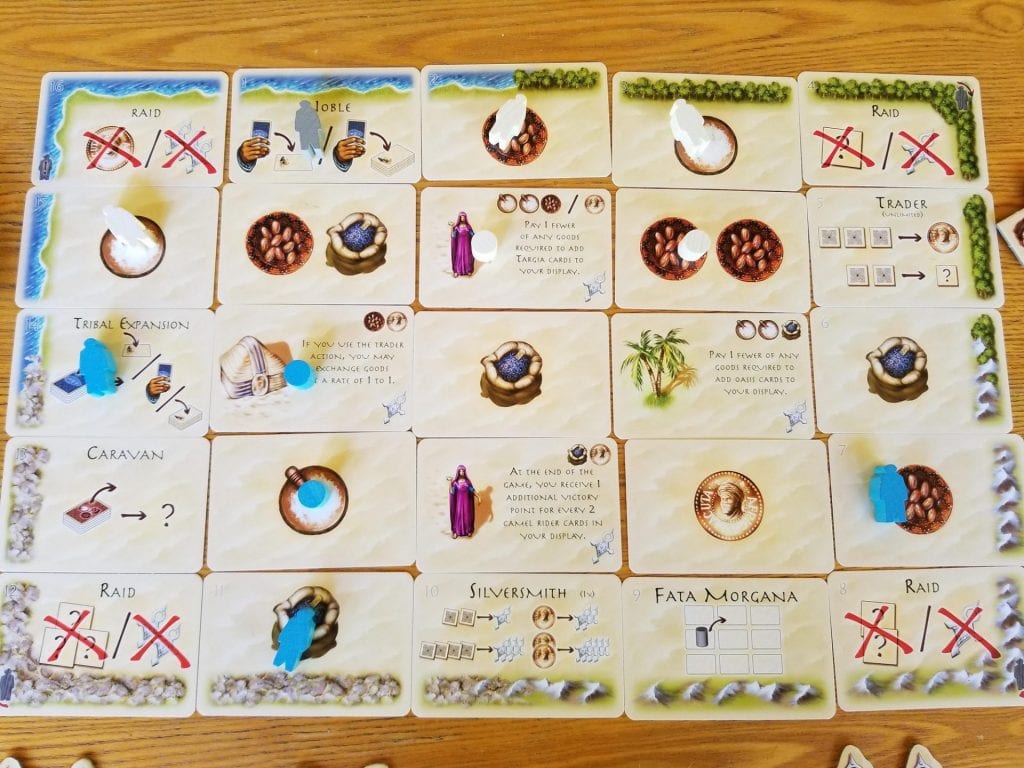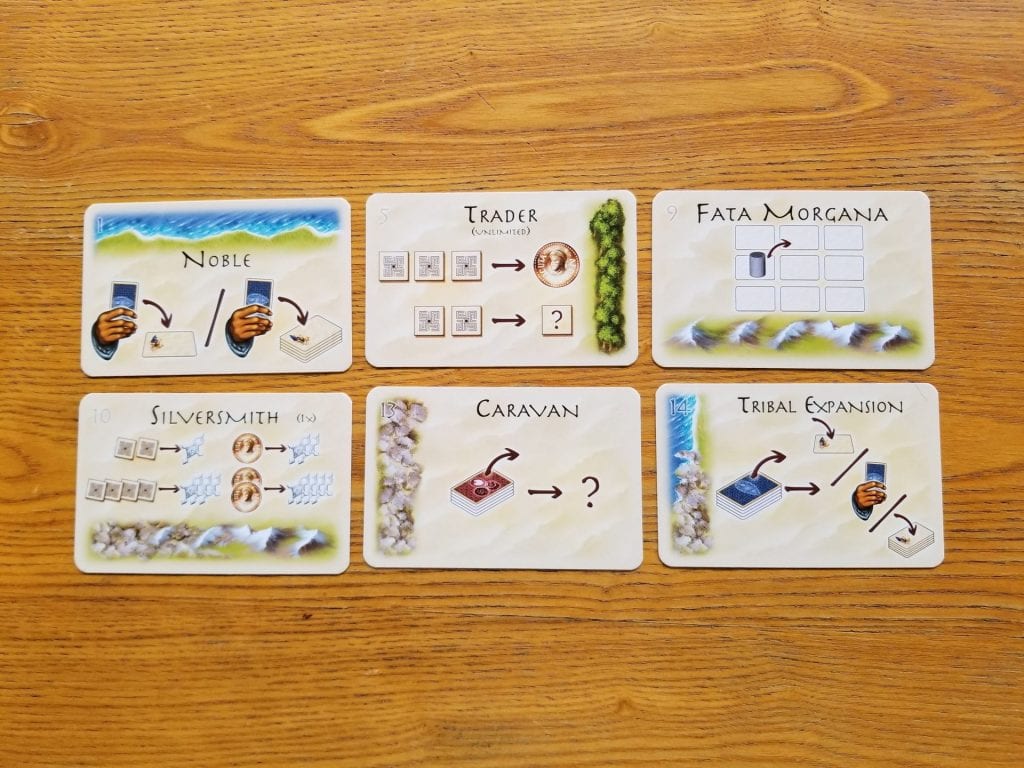Disclosure: Meeple Mountain received a free copy of this product in exchange for an honest, unbiased review. This review is not intended to be an endorsement.
Targi. The name for a male member of the Tuareg tribe, at least according to this game’s rule book. My internet sleuthing has not turned up this particular usage of the word ‘targi’ anywhere other than other articles about this game. According to wikipedia, a male member of the Tuareg tribe is called an Amajagh (or some variant thereof). What is not in question is that the nomadic Tuareg tribe number in the millions. Hailing from Africa, their numbers are spread across a large portion of Northern Africa’s Sahara desert, the central backdrop for this game.
The game of Targi puts the players in control of two opposing Tuareg tribes as they navigate their way through the desert plying their trade of dates, salt, and pepper while establishing settlements along the way. Targi is a worker placement game and, in true worker placement fashion, deciding where to send your tribesmen is as much about setting yourself up for success as it is trying to ensure your opponent doesn’t find success of their own.
The play area is composed of a series of border cards, which will always be the same in every single game, and a random assortment of Goods and Tribe cards that fill up the area in between. Players will be placing their targis (a.ka. – workers) along the borders of the cards, placing their Tribe markers on the inner cards where the lines drawn from their targis intersect, and then performing the actions shown on the cards in an order of their choosing.
In addition to collecting resources, the players will be constructing a tableau of purchased Tribe cards. Some of these have special abilities, but all are worth a number of end game points with bonus points awarded for having multiples of the same type. And this game is all about scoring the most points because, you guessed it, the player with the most at the end of the game wins.
Of course, this is just a high level overview of Targi. If you’d like to learn more about the gameplay, then keep on reading. Otherwise feel free to skip ahead to the Thoughts section to find out what I think.
Back In the Saddle
To begin playing Targi, create the playing area by assembling the border. Each border card is numbered and also contains an illustration which dictates its position. Once the border has been generated, shuffle the Tribe cards and Goods cards into their own separate decks. Each corner of the area between the border cards will receive a randomly drawn face up Goods card with an additional Goods card placed face up in the center. The remaining holes are filled with randomly drawn Tribe cards placed face up. The robber token is placed next to the ‘Noble’ border card.

Each player receives the 3 targis and 2 Tribe markers in their chosen color along with 4 victory points (VP) worth of VP tokens, 1 coin, and 2 of each resource. The remaining coins, VP tokens, and resources are placed close by in a general supply. Then a start player is selected and they receive the start player token. And with that, you’re ready to begin playing Targi.
Through the Desert
At the start of a round, the Robber will move 1 space clockwise around the border. If the Robber moves onto a corner, a raid will occur and the players will be forced to give up a number of resources, gold, or VP tokens. Then the Robber moves onto the next space and the players take their turns. On a player’s turn, they will place one of their targis on 1 of the border cards following these placement rules:
– The targi may never be placed in the same space as the Robber.
– The targi may never be placed on a border card that is directly across from one of their opponent’s targis.
– The targi may not be placed on a corner space.
– Only 1 targi may be placed on any space at a time.
Once the second player has placed their 3rd targi, the players will place their Tribe markers at the locations where imaginary lines drawn from their targis intersect.

Then, beginning with the current start player, each player takes their turn in full by removing their Tribe markers and targis one at a time (in an order of their choosing) and performing the associated action until they have removed them all. The start player token is passed to the next player, any face down cards in the central display are flipped face up (this will make sense momentarily), and a new round begins.
The Desert Trade
Most of the actions players can perform in the game revolve around one of two things: collecting resources or building things. Of the 16 border cards, 6 of them are resource producing cards. At the beginning of the game, there are an additional 5 Goods cards within the center display. Collecting resources is as simple as removing your playing piece from one of these cards and taking whatever is depicted. Whenever a card is taken from the center display it is immediately replaced by a face down card of the opposite type.
The collected resources are used primarily for purchasing Tribe cards to add to your tableau, a 3 x 4 grid of collected Tribe cards. Purchasing a Tribe card is as easy as paying the cost depicted in the upper right hand corner. If a / is present in the cost, this means that the player can pay either of the depicted costs to gain the card. Once purchased, the Tribe card is added to the player’s tableau in the leftmost empty position of any of the 3 rows unless there are already 4 cards present in the row. Once placed, the card may not be moved.

The only differences between Tribe cards are their types – camel rider, oasis, well, dwelling, or targia – and the different abilities they may provide. Some are instant abilities, some are ongoing, and some provide extra VP at the end of the game if certain conditions are met.

There may be a Tribe card that you’d like to add to your tableau, but cannot pay for immediately. You are allowed to hold a single Tribe card in your hand. Be aware, though, that if a better card comes along, you can’t just simply discard the one you’re currently holding to hang onto the better one instead. For that, you’ll need to use the proper border card.
Aside from the 6 goods spaces around the border and the corner cards already discussed, the remaining 6 cards require a bit more explanation. These cards in clockwise order are Noble, Trader, Fata Morgana, Silversmith, Caravan, and Tribal Expansion.

Noble: This allows the player to either place the card in their hand into their tableau or discard it.
Trader: This allows the player to either trade 3 resources of a kind for a single coin or to trade 2 resources of a kind for 1 resource of a different kind. The player may perform as many trades as they want and are able to perform.
Fata Morgana: This allows the player to move one of their Tribe markers from one of the non-border cards to any other unoccupied non-border card.
Silversmith: The player can receive victory points by trading in goods or coins: 2 of a kind for 1 victory point, 4 of a kind for 3 victory points, 1 gold for 2 victory points, or 2 gold for 5 victory points. Unlike the Trader, the Silversmith may only be used once per turn.
Caravan: The player flips over the top card of the Goods deck and receives whatever is shown on the card. The card is then discarded.
Tribal Expansion: The player flips over the top card of the Tribe deck and either pays to add the card to their tableau, add the card to their hand if able, or discard it.
The game comes to an end once the Robber has fully traversed the border spaces or at the end of the round in which a player places their 12th card into their tableau. After handling the robber (if that was indeed the end game trigger), the players tally up their points. Each card is worth the number of points printed on it. If there are 4 cards of the same type in a row, that row scores an additional 4 VP. If there are 4 cards of different types in a row, that row scores an extra 2. Some cards also provide bonus VP for meeting certain criteria. The player with the most VP wins.
Thoughts
Targi is one of the greatest 2-player games that I have ever played.
There. I said it. It’s right out in the open. I fell in love with this game the very first time that I ever played it on Yucata 4 or 5 years ago and I haven’t tired of it yet. I doubt I ever will. There’s just something about Targi that keeps me coming back for more time and time again.
Maybe it’s the theme. Robert Edison Fulton, Jr. once said, “The desert tells a different story every time one ventures into it.” The desert’s borders never change but the actions available within shift like sand dunes. Every resource is scarce and there is fierce competition for it. There are even roving bands of robbers lying in wait for unsuspecting travelers. The feeling of navigating the Sahara’s vast expanse with your tribesmen trying to eke out a living from an unforgiving environment is baked into Targi’s DNA.
Maybe it’s the easy rules set. Targi is a game that only takes a few minutes to teach. Mechanically, there isn’t much to it. Place your targis. Place your Tribe markers. Get some stuff. Many deeply strategic 2-player games have a tendency to overload the players with a lot of conflated rules that take a lot of time to teach (nevermind how long it takes to actually understand and grasp the subtleties of what you’ve actually been taught). Not Targi. Targi keeps it simple and this simplicity makes the game highly approachable.
Maybe it’s the clever way it uses worker placement. I’m a sucker for a good worker placement game and Targi’s one of the best. Like most worker placement games, placing your targis along the border cards deny your opponent access to those actions you’ve covered up. But what makes Targi so clever is that while you’re doing this, you’re also jockeying for position to claim one of the actions in the inner display. You’ll find yourself praying that your opponent doesn’t choose a border card that blocks you from being able to pick up the card you were hoping to pick up. Targi is really good at building up this kind of tension and I love it.
Maybe it’s the brain-burning decisions I’m forced to make. This ties into my previous statement. Each card in the inner display requires the correct placement of 2 targis on the border cards in order to obtain it. This forces you to have to consider which border card is most important to you which forces you to have to come up with a backup plan should the other card get taken by the other player. Then again, it pays to watch what your opponents are up to. If a player has 3 camel rider cards in a row and there’s a camel rider card in the inner display, it’s a pretty good bet which card they’ll be gunning for and it might behoove you to block them even if it would mean just having to discard the card due to not being able to pay for it or hold it in your hand. Many games of Targi come down to a difference of a handful of points. Allowing the other player to gain that 4 VP bonus could mean the difference between you winning and you losing.
Maybe it’s the way that it makes me have to think on my feet. To paraphrase Robert Burns: “The best laid plans…oft fail.” This was never more true than it is in a game of Targi. No matter how much you jockey, no matter how hard you wish, no matter how often you pray, it is inevitable that your opponent is going to mess up your plans at some point. There will be times where you will be forced to make a suboptimal move or, worse yet, scrap your strategy entirely and come up with a new one on the fly. Targi is masterful at crafting these kinds of uncomfortable situations. Your plans will be ruined and you will emerge a better player for it.
Or maybe it’s all of these reasons and more. Why pick and choose when you can have it all? And, trust me, Targi delivers. I have never played a game of Targi that was anything less than thrilling and intense. I have never enjoyed a session of Targi that didn’t make me feel exceedingly clever at some point.
If that sounds like the kind of 2-player experience you’re after, then this is definitely the right game for you. So grab a friend, harness a camel, and get playing.
But watch out for that robber. He’s a jerk.












I have been on the fence about getting and/or playing this game for some time. This review is exactly what I needed to push me over and get me to go out and get this game for myself. Thanks!